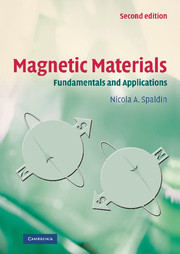Book contents
- Frontmatter
- Contents
- Acknowledgments
- I Basics
- 1 Review of basic magnetostatics
- 2 Magnetization and magnetic materials
- 3 Atomic origins of magnetism
- 4 Diamagnetism
- 5 Paramagnetism
- 6 Interactions in ferromagnetic materials
- 7 Ferromagnetic domains
- 8 Antiferromagnetism
- 9 Ferrimagnetism
- 10 Summary of basics
- II Magnetic phenomena
- III Device applications and novel materials
- Epilogue
- Solutions to selected exercises
- References
- Index
10 - Summary of basics
from I - Basics
Published online by Cambridge University Press: 05 June 2012
- Frontmatter
- Contents
- Acknowledgments
- I Basics
- 1 Review of basic magnetostatics
- 2 Magnetization and magnetic materials
- 3 Atomic origins of magnetism
- 4 Diamagnetism
- 5 Paramagnetism
- 6 Interactions in ferromagnetic materials
- 7 Ferromagnetic domains
- 8 Antiferromagnetism
- 9 Ferrimagnetism
- 10 Summary of basics
- II Magnetic phenomena
- III Device applications and novel materials
- Epilogue
- Solutions to selected exercises
- References
- Index
Summary
We've now worked our way through all of the most important types of magnetic ordering, and discussed the microscopic arrangements of the magnetic moments and the physics and chemistry that determine them. We've also described the resulting macroscopic behavior in each case. Before we move on, let's summarize the basics that we have learned so far.
Review of types of magnetic ordering
Remember that we have covered four main classes of magnetic materials: the para-, antiferro-, ferro-, and ferrimagnets. In Fig. 10.1 we reproduce the local ordering and magnetization curves, which we first introduced in Chapter 2, for each of the classes. Let's summarize their properties:
Paramagnets. The individual atoms or ions have magnetic moments, but these moments are disordered, so that there is no net magnetization. The susceptibility is positive, because the external field causes the moments to partially align with it; and it is small, because the thermal energy which tends to disorder the moments is large compared with the magnetic energy that tends to align them along the field direction.
Antiferromagnets. Here the magnetic moments on the individual atoms or ions align in an antiparallel fashion so as, overall, to cancel each other out. As in the case of the paramagnets, there is no net zero-field magnetization and a small positive susceptibility; note that the microscopic structure is very different, however.
Ferromagnets. In the ferromagnets the moments align parallel to each other, yielding a large net magnetization.
- Type
- Chapter
- Information
- Magnetic MaterialsFundamentals and Applications, pp. 130 - 132Publisher: Cambridge University PressPrint publication year: 2010



